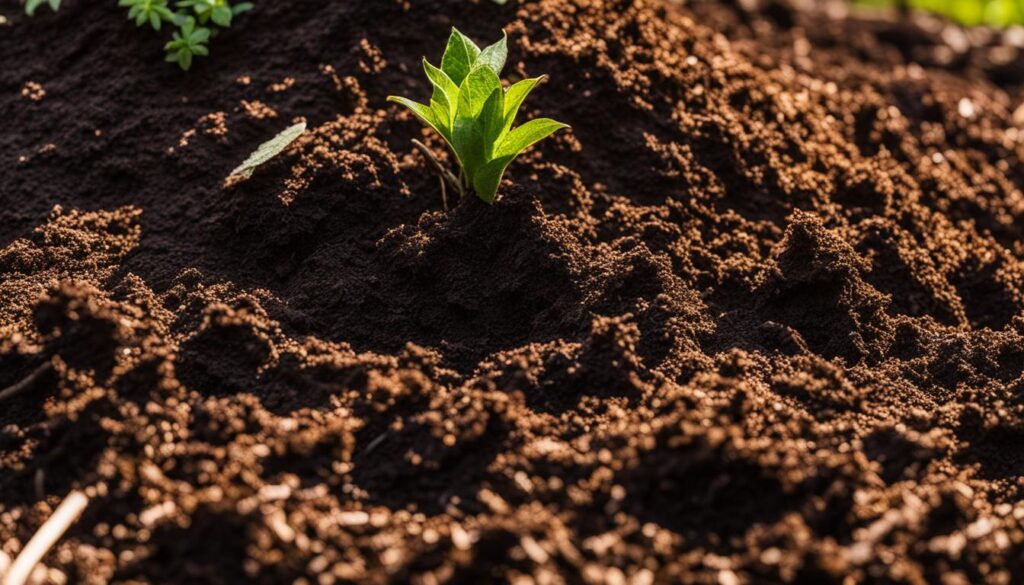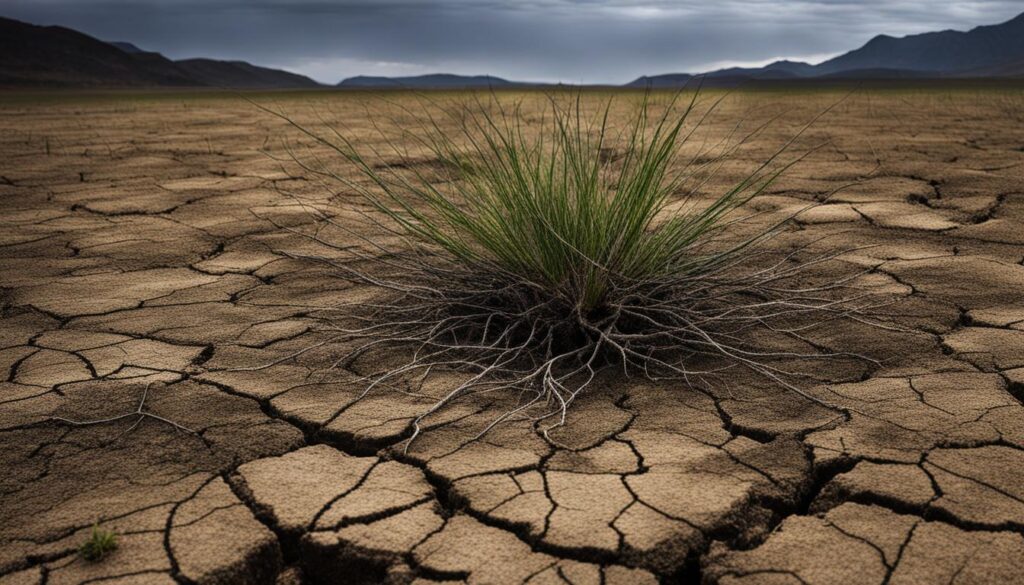Taking care of your xeriscape landscape during a drought is crucial for its survival. With the right steps and maintenance practices, you can ensure the health and longevity of your xeriscape garden. This checklist provides 14 essential tips to care for your yard during a drought and prepare it for the future.
Key Takeaways:
- Proper maintenance is vital for the survival of your xeriscape landscape during a drought.
- Delay new landscaping projects that add stress to already struggling plants.
- Continue fertilizing your plants with a high-nitrogen fertilizer to provide necessary nutrients.
- Mulching grass clippings instead of bagging them helps retain water and promotes lawn health.
- Mow your lawn with a high blade setting to encourage deep root growth and cooler topsoil.
Pass On Greenery Enhancing Projects For Now
During a drought, it is advisable to hold off on any new landscaping projects that add stress to already struggling plants. This includes aeration, laying new sod, and planting new trees, shrubs, or flowers. Waiting for more conducive conditions will promote better growth and proper watering patterns.
Instead, focus on preserving the existing greenery in your landscape. By providing proper maintenance and care to your current plants, you can ensure their survival during the drought. Use this time to implement water-saving measures and strategies that will benefit your existing greenery.
As the saying goes, “A stitch in time saves nine.” By being patient and postponing greenery enhancing projects for now, you can avoid unnecessary setbacks and ensure the long-term health of your landscape.
Don’t Put Off Fertilizing
Even during a drought, it’s important to continue fertilizing your plants. Use a high-nitrogen fertilizer to provide them with the necessary nutrients, especially when water is limited. This will help ensure their health and resilience during dry periods.
When water is scarce, plants may struggle to absorb enough nutrients from the soil. Fertilizing with a high-nitrogen fertilizer can help compensate for this by supplying additional nutrients that may be lacking. Nitrogen is an essential nutrient for plant growth, promoting healthy foliage and overall plant vigor.
To optimize the effectiveness of the fertilizer, apply it according to the package instructions and time it correctly. Applying the fertilizer in the early morning or late evening when temperatures are cooler can help minimize nutrient loss and increase absorption by the plants. Additionally, make sure to water the area thoroughly after application to help activate the fertilizer and ensure it reaches the root zone.
Benefits of Fertilizing During a Drought:
- Enhances plant health: High-nitrogen fertilizers provide essential nutrients for plants, promoting their overall health and resilience even in challenging drought conditions.
- Boosts drought tolerance: Fertilizing with a high-nitrogen fertilizer can help plants withstand drought stress by improving their ability to absorb and utilize available water efficiently.
- Promotes root development: The nutrients provided by the fertilizer encourage robust root growth, enabling plants to access moisture deeper in the soil.
- Encourages new growth: Applying fertilizer during a drought can stimulate new growth, aiding in the recovery of drought-stressed plants once watering restrictions are lifted.
Remember, using a high-nitrogen fertilizer during a drought is not a substitute for proper watering practices. Be mindful of local water restrictions and prioritize efficient water use to minimize the impact of the drought on your landscape.
By continuing to fertilize your plants with a high-nitrogen fertilizer, you can provide them with the necessary nutrients to withstand drought conditions. However, it’s important to monitor your plants’ response to the fertilizer and adjust the application rate as needed. Consulting with a professional landscaper can help you determine the most appropriate fertilizer and application schedule for your specific plants and local conditions.
Remember, fertilizing alone may not be enough to sustain your landscape during a drought. Implementing additional water-saving practices, such as mulching, proper watering techniques, and plant selection, can further support the health and longevity of your xeriscape garden. With careful attention and proper maintenance, your drought-resistant plants can thrive and beautify your landscape even during challenging drought periods.
Mulch Rather Than Bagging
When it comes to maintaining a healthy and drought-resistant lawn, one of the best practices you can adopt is mulching instead of bagging your grass clippings. Instead of wasting time and effort bagging the clippings, consider allowing your mower to mulch them back onto the lawn. This not only saves you time but also provides numerous benefits for your grass.
Mulching grass clippings adds extra nutrition to the soil, providing essential nutrients that promote healthy growth. Additionally, the mulch acts as a natural water retention system, helping the grass retain moisture during watering restrictions or drought conditions. By allowing the clippings to decompose on the lawn, you’re essentially feeding your grass and helping it stay hydrated, all while reducing the need for excessive watering.
Furthermore, mulching helps regulate soil temperature by keeping the topsoil cooler, preventing excessive heat from damaging the grass roots. This creates a more favorable environment for your lawn to thrive, even during hot and dry periods. With regular mulching, you’ll notice improved overall health and resilience in your grass, making it better equipped to withstand drought conditions.
When mulching your grass clippings, it’s important to mow frequently and maintain the appropriate blade height. Aim to mow your lawn when the grass is dry and keep the blade set at a height that leaves the grass no shorter than 3 inches. This ensures that the clippings will be small enough to decompose quickly and won’t smother the grass.
By mulching instead of bagging, you not only save time and effort but also contribute to the overall health and water retention of your lawn. So, the next time you’re tempted to reach for the grass clippings bag, consider making the switch to mulching and give your lawn the added benefits it deserves.
Mow High
When it comes to mowing your drought-stressed lawn, it’s essential to take a proactive approach. Setting your mower blade at a high setting is a simple but effective way to promote the health and resilience of your grass. By keeping the grass blades longer, you encourage deeper root growth, which helps the grass withstand periods of limited water availability.
Longer grass blades also have a cooling effect on the topsoil, reducing heat stress on the lawn. This is especially important during a drought when the sun’s intense rays can dry out the soil and damage the grass. By mowing high, you create a protective layer that shades the topsoil, helping to retain moisture and promote overall lawn health.
Remember, a drought-stressed lawn may take longer to recover. By mowing high and taking extra care of your grass, you increase the chances of it bouncing back to life once conditions improve. So, for a lush and resilient lawn, adjust your mower blade to a high setting and mow with confidence.
How Do I Maintain a Xeriscaped Landscape to Keep It Looking Great?
Maintaining a xeriscaped landscape to keep it looking great is easy with simple xeriscaping design ideas. Use drought-tolerant plants, add mulch to retain moisture, and install a drip irrigation system for efficient watering. Limiting lawn space and incorporating decorative rock or gravel can also help conserve water.
Managing Weed Growth
Weeds can be a significant concern for your drought-stressed landscaping. Not only do they compete with your desired plants for water and nutrients, but they can also hinder their growth and overall health. It’s crucial to implement effective weed control strategies to ensure the survival and success of your plants.
Prevention is Key
One of the most effective ways to manage weed growth is through prevention. By taking proactive measures, you can reduce the likelihood of weeds invading your xeriscape garden. Applying a layer of mulch around your plants can act as a barrier, preventing weed seeds from germinating and establishing themselves. Additionally, regularly inspecting your garden for any signs of weeds and promptly removing them can help prevent rapid weed growth.
Targeted Weed Removal
When it comes to removing existing weeds, it’s important to do so systematically. Hand-pulling weeds is a practical and environmentally friendly approach, especially for smaller infestations. Ensure you remove the entire weed, including the roots, to prevent regrowth. For larger infestations, using a hoe or garden fork to loosen the soil and remove weeds can be more efficient.
“Preventing weeds from taking over your xeriscape garden requires consistent effort and vigilance. By implementing preventative measures and targeting weed removal, you can ensure that your plants have the best chance of thriving amidst the challenges of a drought.”
Consider Natural Weed Control Methods
In addition to manual weed removal, you may also consider natural weed control methods. For example, vinegar can be an effective weed killer when applied directly to the foliage of unwanted plants. Similarly, boiling water can be poured over weeds to destroy them. However, it’s important to exercise caution when using these methods to avoid harming your desired plants.
Managing weed growth is an essential aspect of maintaining your xeriscape landscape during a drought. By adopting preventive measures, systematically removing existing weeds, and considering natural weed control methods, you can protect your plants from nutrient stealing and water competition. With proper weed management, your xeriscape garden will have a better chance of thriving even in challenging conditions.
Conclusion
Maintaining a xeriscape landscape during a drought requires strategic planning and diligent landscape maintenance. By following the checklist provided, you can protect your plants and ensure their long-term survival.
For future landscaping projects, consider incorporating drought-resistant plants and removing non-native species. Installing drip irrigation systems and redesigning park strips to be more water-efficient can also contribute to a more sustainable garden.
Remember, trusting in nature’s resilience and seeking the expertise of a professional landscaper can help create a lush, low-water garden that thrives all year round. With proper care and attention, your xeriscape garden will not only survive but also thrive amidst drought conditions.












